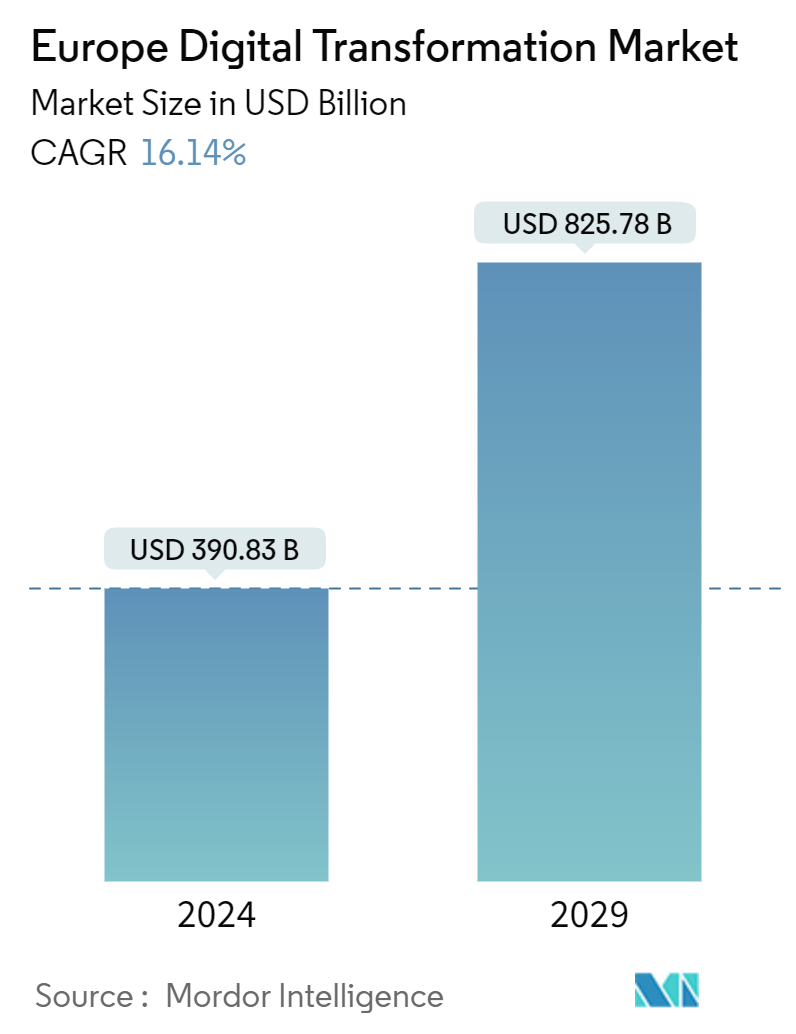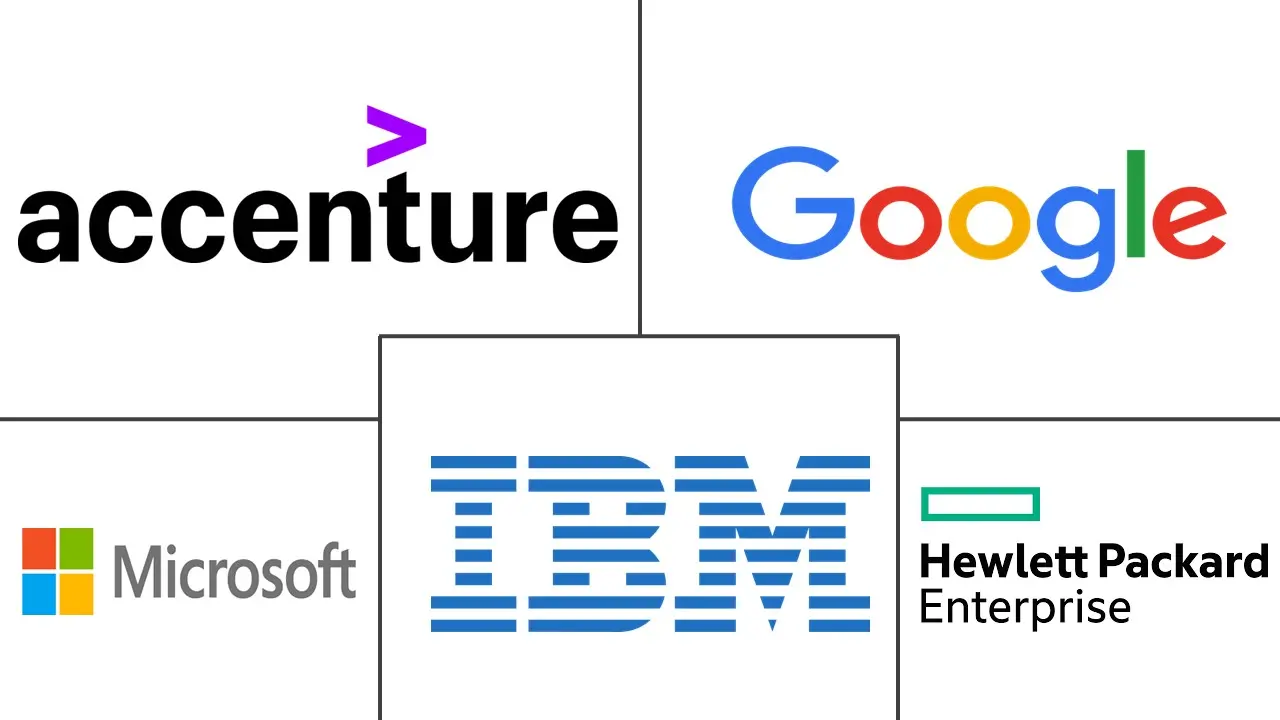Market Size of Europe Digital Transformation Industry

| Study Period | 2019 - 2029 |
| Base Year For Estimation | 2023 |
| Forecast Data Period | 2024 - 2029 |
| Market Size (2024) | USD 390.83 Billion |
| Market Size (2029) | USD 825.78 Billion |
| CAGR (2024 - 2029) | 16.14 % |
| Market Concentration | Low |
Major Players
*Disclaimer: Major Players sorted in no particular order |
Europe Digital Transformation Market Analysis
The Europe Digital Transformation Market size is estimated at USD 390.83 billion in 2024, and is expected to reach USD 825.78 billion by 2029, growing at a CAGR of 16.14% during the forecast period (2024-2029).
- Europe is experiencing significant growth in digital transformation, fundamentally altering industries and economic dynamics. This evolution involves the widespread integration of digital technologies across business functions, reshaping operational paradigms and customer value propositions. Key drivers behind Europe's digital transformation include technological advancements, evolving consumer behaviors, and strategic governmental initiatives, all aimed at enhancing innovation and competitiveness.
- European governments are actively promoting digital transformation through various policies and initiatives. The European Union's Digital Strategy aims to make Europe fit for the digital age by fostering innovation, improving infrastructure, and ensuring a fair and competitive digital economy. Initiatives such as the Digital Europe Programme and the General Data Protection Regulation (GDPR) create a conducive environment for digital innovation while protecting consumer rights. In December 2023, The European Commission 2024 approved an amendment to the EU Digital Europe Program, allocating a substantial USD 829.09 million. This funding is specifically earmarked to drive digital transformations across Europe, focusing on enhancing citizens' lives, bolstering public services, and empowering businesses within the member states.
- Further, various sectors in Europe are witnessing an adoption of digitalization. For instance, the European retail industry has substantially shifted towards e-commerce. Online shopping platforms, digital payment systems, and personalized marketing strategies are transforming retail. Retailers use data analytics to understand consumer behavior better and optimize supply chains. The rise of online marketplaces and direct-to-consumer brands is changing the sector's competitive dynamics.
- In March 2024, German retailer REWE Group partnered with Israeli startup Catch to trial Catch AI, a versatile platform spanning smart carts, smartphones, and self-checkout kiosks. This innovation empowers shoppers to scan handwritten lists or seamlessly transfer digital lists via a tablet. Notably, the system prioritizes user anonymity, eliminating the need for registrations or app downloads.
- Moreover, Europe's digital transformation is poised for a bright future. With technology's relentless evolution, fresh avenues are set to open up for both businesses and public sector entities. To maintain this digital momentum, it's imperative to consistently invest in emerging technologies, enhance workforce skills, and prioritize cybersecurity. Moreover, fostering partnerships among governments, industries, and academia is pivotal to tackling hurdles and amplifying this transformation's gains. Given Europe's dedication to nurturing a digital economy and its deep-rooted innovative legacy, the continent stands primed to take the helm in the worldwide digital arena.
Europe Digital Transformation Industry Segmentation
Digital transformation is the process of incorporating digital technologies such as artificial intelligence and machine learning, extended reality (VR & AR) for industrial applications, IoT, industrial robotics, blockchain, digital twins, 3D printing/ additive manufacturing, industrial cyber security, wireless connectivity, edge computing, smart mobility, and others across various end-user industries.
Europe digital transformation market is segmented by type (analytics, artificial intelligence and machine learning, extended reality (XR), IoT, industrial robotics, blockchain, additive manufacturing/3D printing, cyber security, cloud edge computing, and others (digital twin, mobility and connectivity)), and country (Germany, France, United Kingdom, Italy, Spain, and Other European Countries). The market sizes and forecasts are provided in terms of value (USD) for the above segment.
| By Type | |||||||
| |||||||
| |||||||
| |||||||
| |||||||
| |||||||
| |||||||
| |||||||
| |||||||
|
| By End-User Industry | |
| Manufacturing | |
| Oil, Gas and Utilities | |
| Retail & e-commerce | |
| Transportation and Logistics | |
| Healthcare | |
| BFSI | |
| Telecom and IT | |
| Government and Public Sector | |
| Others (Education, Media & Entertainment, Environment etc) |
| By Country | |
| Germany | |
| France | |
| United Kingdom | |
| Italy | |
| Spain | |
| Other European Countries |
Europe Digital Transformation Market Size Summary
The Europe Digital Transformation Market is undergoing substantial growth, driven by the integration of digital technologies across various sectors. This transformation is reshaping industries and economic dynamics, with key drivers including technological advancements, changing consumer behaviors, and strategic governmental initiatives. European governments, particularly through the European Union's Digital Strategy, are actively promoting digital transformation by enhancing infrastructure and fostering a competitive digital economy. Initiatives like the Digital Europe Programme and GDPR create a supportive environment for innovation while safeguarding consumer rights. The retail sector, for instance, is experiencing a significant shift towards e-commerce, with digital payment systems and personalized marketing strategies becoming prevalent. This shift is exemplified by innovations such as the partnership between German retailer REWE Group and Israeli startup Catch, which trialed advanced AI-driven shopping solutions.
The adoption of artificial intelligence (AI) is a notable trend in Europe, supported by a robust research and development ecosystem and collaboration between public and private sectors. European businesses are increasingly leveraging AI technologies, with significant investments in research and innovation driving this trend. The UK's digital transformation is characterized by the proliferation of advanced technologies like AI, machine learning, and IoT, which are optimizing operations and enhancing customer experiences. The country's well-developed ICT infrastructure and growing number of startups are contributing to this growth. Key players in the digital transformation market, such as Accenture, Google, IBM, and Microsoft, are actively expanding their presence and forming strategic partnerships to consolidate their positions. Initiatives like AMD's acquisition of Silo AI and the launch of the EU Digital Twin Ocean platform highlight the ongoing commitment to advancing digital transformation across Europe.
Europe Digital Transformation Market Size - Table of Contents
-
1. MARKET DYNAMICS
-
1.1 Market Drivers
-
1.1.1 Increase in the adoption of big data analytics and other technologies in the region
-
1.1.2 The rapid proliferation of mobile devices and apps
-
-
1.2 Market Restraints
-
1.2.1 Concerns about the Privacy and Security of Information
-
-
-
2. MARKET SEGMENTATION
-
2.1 By Type
-
2.1.1 Artificial Intelligence and Machine Learning
-
2.1.1.1 Current Market Scenario and Market Projections for the Forecast Period
-
2.1.1.2 Key Growth Influencers (Drivers, Challenges, and Opportunities)
-
2.1.1.3 Use Case Analysis
-
2.1.1.4 Market Outlook
-
-
2.1.2 Extended Reality (VR & AR)
-
2.1.2.1 Current Market Scenario and Market Projections for the Forecast Period
-
2.1.2.2 Key Growth Influencers (Drivers, Challenges, and Opportunities)
-
2.1.2.3 Use Case Analysis
-
2.1.2.4 Market Outlook
-
-
2.1.3 IoT
-
2.1.3.1 Current Market Scenario and Market Projections for the Forecast Period
-
2.1.3.2 Key Growth Influencers (Drivers, Challenges, and Opportunities)
-
2.1.3.3 Use Case Analysis
-
2.1.3.4 Market Outlook
-
-
2.1.4 Industrial Robotics
-
2.1.4.1 Current Market Scenario and Market Projections for the Forecast Period
-
2.1.4.2 Key Growth Influencers (Drivers, Challenges, and Opportunities)
-
2.1.4.3 Use Case Analysis
-
2.1.4.4 Market Outlook
-
-
2.1.5 Blockchain
-
2.1.5.1 Current Market Scenario and Market Projections for the Forecast Period
-
2.1.5.2 Key Growth Influencers (Drivers, Challenges, and Opportunities)
-
2.1.5.3 Market Outlook
-
-
2.1.6 Additive Manufacturing/3D Printing
-
2.1.6.1 Current Market Scenario and Market Projections for the Forecast Period
-
2.1.6.2 Key Growth Influencers (Drivers, Challenges, and Opportunities)
-
2.1.6.3 Use Case Analysis
-
2.1.6.4 Market Outlook
-
-
2.1.7 Cybersecurity
-
2.1.7.1 Current Market Scenario and Market Projections for the Forecast Period
-
2.1.7.2 Key Growth Influencers (Drivers, Challenges, and Opportunities)
-
2.1.7.3 Use Case Analysis
-
2.1.7.4 Market Outlook
-
-
2.1.8 Cloud Edge Computing
-
2.1.8.1 Current Market Scenario and Market Projections for the Forecast Period
-
2.1.8.2 Key Growth Influencers (Drivers, Challenges, and Opportunities)
-
2.1.8.3 Use Case Analysis
-
2.1.8.4 Market Outlook
-
-
2.1.9 Others (digital twin, mobility and connectivity)
-
2.1.9.1 Current Market Scenario and Market Projections for the Forecast Period
-
2.1.9.2 Key Growth Influencers (Drivers, Challenges, and Opportunities)
-
2.1.9.3 Market Breakdown by Type (Digital Twin, Mobility and Connectivity)
-
2.1.9.4 Use Case Analysis
-
2.1.9.5 Market Outlook
-
-
-
2.2 By End-User Industry
-
2.2.1 Manufacturing
-
2.2.2 Oil, Gas and Utilities
-
2.2.3 Retail & e-commerce
-
2.2.4 Transportation and Logistics
-
2.2.5 Healthcare
-
2.2.6 BFSI
-
2.2.7 Telecom and IT
-
2.2.8 Government and Public Sector
-
2.2.9 Others (Education, Media & Entertainment, Environment etc)
-
-
2.3 By Country
-
2.3.1 Germany
-
2.3.2 France
-
2.3.3 United Kingdom
-
2.3.4 Italy
-
2.3.5 Spain
-
2.3.6 Other European Countries
-
-
Europe Digital Transformation Market Size FAQs
How big is the Europe Digital Transformation Market?
The Europe Digital Transformation Market size is expected to reach USD 390.83 billion in 2024 and grow at a CAGR of 16.14% to reach USD 825.78 billion by 2029.
What is the current Europe Digital Transformation Market size?
In 2024, the Europe Digital Transformation Market size is expected to reach USD 390.83 billion.

